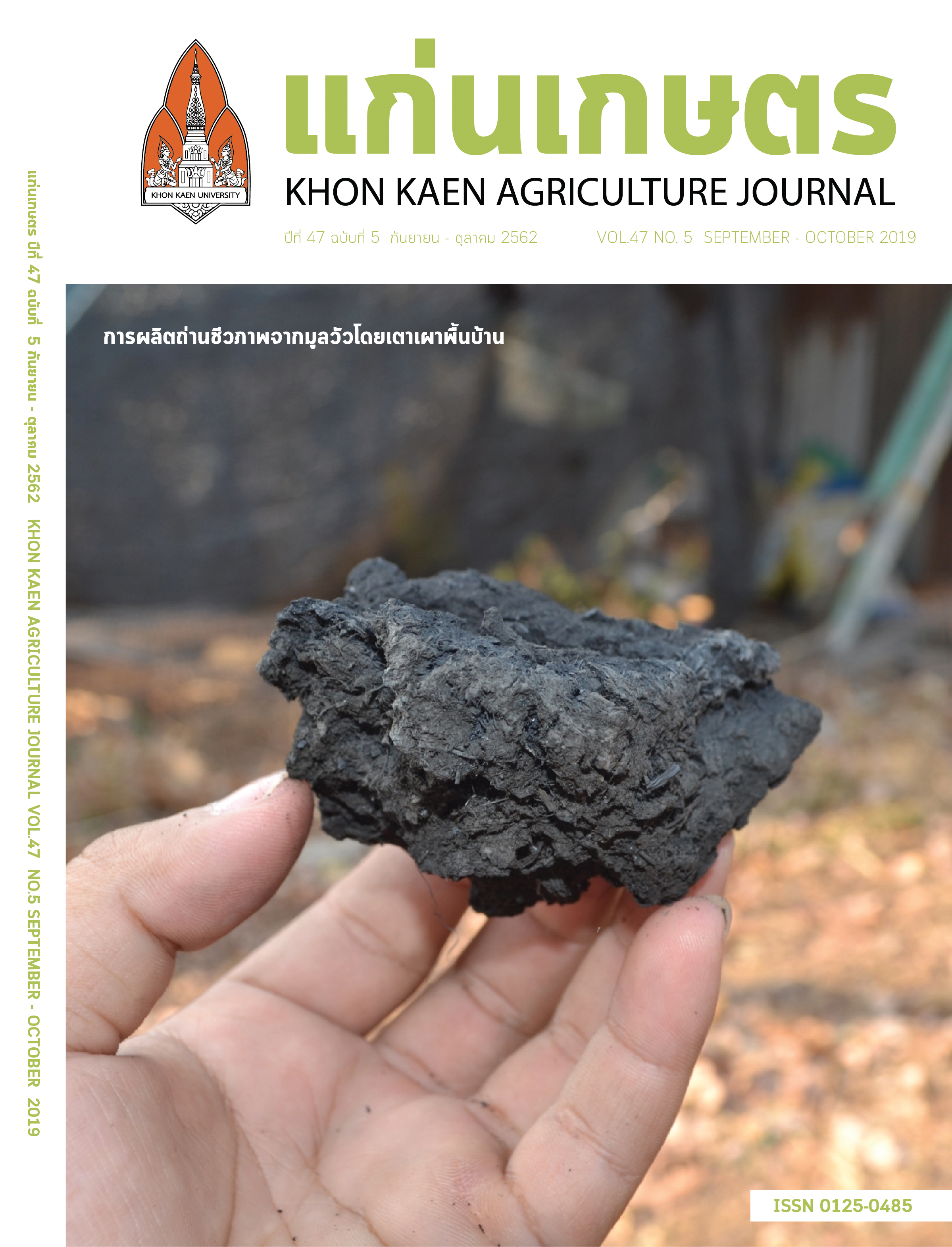การปรับปรุงคุณภาพวัสดุอินทรีย์เพื่อลดการปลดปล่อยก๊าซคาร์บอนไดออกไซด์ (CO2)สู่บรรยากาศ และส่งเสริมการสะสมคาร์บอนในดินร่วนปนทรายอินทรียวัตถุต่ำ
Main Article Content
บทคัดย่อ
การศึกษานี้มีวัตถุประสงค์เพื่อศึกษาผลของการใส่วัสดุอินทรีย์ที่มีองค์ประกอบทางเคมีแตกต่างกันในดินต่อการเปลี่ยนแปลงกิจกรรมเอนไซม์หมุนเวียนคาร์บอน (C) ได้แก่ อินเวอเตส เบต้ากลูโคสิเดส ฟีนอลออกซิเดส และเปอร์ออกซิเดส และความสัมพันธ์ระหว่างกิจกรรมของเอนไซม์กับสมบัติดินบางประการ การทดลองประกอบด้วย 4 กรรมวิธีทดลอง ดังนี้ 1) กรรมวิธีควบคุม 2) ดิน + ฟางข้าว 3) ดิน + ปุ๋ยหมักถ่านชีวภาพ และ 4) ดิน + ถ่านชีวภาพ ผลการศึกษาแสดงให้เห็นว่ากรรมวิธีดิน + ปุ๋ยหมักถ่านชีวภาพมีกิจกรรมของอินเวอเตสสูงกว่ากรรมวิธีอื่นอย่างมีนัยสำคัญทางสถิติ (P < 0.05) ตั้งแต่ช่วงกลางจนถึงช่วงท้ายของการย่อยสลาย (0.17 - 0.29 mg GE g-1 soil DW 3h-1) ขณะที่กรรมวิธีดิน + ฟางข้าว มีกิจกรรมของเบต้ากลูโคสิเดสสูงกว่าทุกกรรมวิธีอย่างมีนัยสำคัญทางสถิติ (P < 0.05) ตั้งแต่วันที่ 7 หลังการบ่ม (28.9 - 56 μg p-nitrophenol g-1 soil DW h-1) บ่งชี้ได้ชัดเจนว่าฟางข้าวมีเซลลูโลสเป็นสารตั้งต้นในปริมาณที่สูง ขณะที่กรรมวิธีดิน + ถ่านชีวภาพ มีกิจกรรมของฟีนอลออกซิเดสเพิ่มขึ้นสูงกว่าทุกกรรมวิธีตลอดระยะเวลาการบ่ม โดยพบความแตกต่างอย่างมีนัยสำคัญทางสถิติในวันที่ 21 42 และ 63 (P < 0.05) มีค่าเท่ากับ 0.4 0.88 and 0.67 μmol dicq g-1 soil DW h-1 ตามลำดับ การศึกษานี้พบความสัมพันธ์ในทางบวกระหว่างไนโตรเจน (N) กับกิจกรรมของอินเวอเตสและเบต้ากลูโคสิเดสในช่วงกลางถึงท้ายของการย่อยสลายแต่ไม่พบความสัมพันธ์ทางลบระหว่าง N กับกิจกรรมเอนไซม์ที่ย่อย C ส่วนที่ยากต่อการย่อยสลาย การศึกษานี้ยังแสดงให้เห็นว่าจุลินทรีย์ภายใต้สภาวะขาดแคลน C จากวัสดุอินทรีย์เป็นระยะเวลานานโดยเฉพาะในดินที่มีอินทรียวัตถุต่ำสามารถถูกเหนี่ยวนำให้ผลิตเอนไซม์ได้จากการใส่ C ที่ยากต่อการย่อยสลายลงในดิน การศึกษานี้พบว่ากรรมวิธีดิน + ปุ๋ยหมักถ่านชีวภาพส่งผลให้มีค่า qCO2 ต่ำสุด (0.078 mg CO2-C g-1 microbial biomass C d-1) สะท้อนการใช้ประโยชน์จากคาร์บอนโดยจุลินทรีย์ได้สูงสุด การศึกษานี้สามารถสรุปได้ว่าปุ๋ ยหมักจากถ่านชีวภาพเหมาะสมที่สุดในการนำมาปรับปรุงดินเนื้อร่วนปนทรายเพื่อเพิ่มการสะสมคาร์บอนในดินที่มีอินทรียวัตถุต่ำ
Article Details
เอกสารอ้างอิง
ภาณุเดชา กมลมานิทย์, ณัฐพงษ์ พานวงษ์ และ พฤกษา หล้าวงษา. 2561. อิทธิพลของอัตราส่วนถ่านชีวภาพต่อฟางข้าวร่วมกับมูลแพะต่อคุณสมบัติทางกายภาพ เคมี และชีววิทยาของปุ๋ ยหมัก. แก่นเกษตร. 46: 843-856.
Aciego Pietri J. C. and P. C. Brookes. 2009. Substrate inputs and pH as factors controlling microbial biomass, activity and community structure in an arable soil. Soil Biol. Biochem. 41: 1396-1405.
Adetunji, A. T., F. B. Lewu, R. Mulidzi, and B. Ncube. 2017. The biological activities of B-glucosidase, phosphatase and urease as soil quality indicators: a review. J. Soil Sci. Plant Nutr. 17: 794-807.
Alef, K., and P. Nannipieri. 1995. Methods in Applied Soil Microbiology and Biochemistry: Enzyme Activities. Academic Press, London.Anderson, T. H., and K. H. Domsch. 1993. The metabolic quotient for CO2 (qCO2) as a specific activity parameter to assess the effects of environmental conditions, such as pH, on the microbial biomass of forest soils. Soil Biol. Biochem. 25: 393-395.
Asio, V. B., R. Jahn, F. O. Perez, I. A. Navarrete, S. M. Jr. Abit. 2009. A review of soil degradation in the Philippines. Annals of Tropical Research. 31: 69-94.
Benintende, S. M., M. C. Benintende, M. A. Sterren and J. J. Bettista. 2008. Soil microbiological indicates of soil quality in four rice rotations systems. Ecol. Indicat. 8: 704-708.
Berg, B. and E. Matzner. 1997. Effect of N deposition on decomposition of plant litter and soil organic matter in forest systems. Environ. Review. 5: 1-25.
Blagodatsky, S. A., I. V. Yevdokimov, A. A. Larionova and J. Richter. 1998. Microbial growth in soil and nitrogen turnover: model calibration with laboratory data. Soil Biol. Biochem. 30: 1757-1764.
Carreiro, M. M., R. L. Sinsabaugh, D. A. Repert and D. F. Parkhurst. 2000. Microbial enzyme shifts explain litter decay responses to simulated nitrogen deposition. Ecology. 81: 2359-2365.
Coyne, M. S. 1999. Soil microbiology: An exploratory approach. Delmar publishers. New York, U.S.A.De Forest, J. L., D. R. Zak, K. S. regitzer, A. J. Burton. 2004. Anthropogenic NO3- deposition alters microbial community function in northern hardwood forests. Soil Sci Soc. Am. J. 68: 132-138.
Gallo, M. E., R. Amonette, C. Lauber, R. L. Sinsabaugh, D. R. Zak. 2004. Short-term changes in oxidative enzyme activity and microbial community structure in nitrogen-amended north temperate forest soils. Microb. Ecol. 48: 218-229.
Hendel, B., R. L. Sinsabaugh and J. Marxsen. 2005. Lignin-degrading enzymes: phenoloxidase and peroxidase. In: M.A.S. Graça, F. Bärlocher, and M.O. Gessner. (Eds.). Methods to study litter decomposition: a practical guide, Springer, Dordrecht.Kamara, A., H. S. Kamara, and M. S.Kamara. 2015. Effect of rice straw biochar on soil quality and the early growth and biomass yield of two rice varieties. Agric. Sci. 6: 798-806.
Kamolmanit, B., P. Vityakon, W. Kaewpradit, G. Cadisch and F. Rasche. 2013. Soil fungal communities and enzyme activities in a sandy, highly weathered tropical soil treated with biochemically contrasting organic inputs. Biol. Fertil. Soils. 49: 905-917.
Kanerva, S., V. Kitunen, O. Kiikkilä, J. Loponen and A. Smolander. 2006. Response of soil C and N transformations to tannin fractions originating from Scots pine and Norway spruce needles. Soil Biol. Biochem. 38: 1364-1374.
Kochsiek, A. E. and J. M. H. Knops. 2013. Effects of nitrogen availability on the fate of litter-carbon and soil organic matter decomposition. Br. J. Environ. Clim. Change. 3: 24-43.
Kuzyakov, Y., J. K. Friedel and K. Stahr. 2000. Review of mechanisms and quantification of priming effect. Soil Biol. Biochem. 32: 1485-1498.
Niemi, R. M., M. Vepsalainen, K. Wallenius, K. Erkomaa, S. Kukkonen and M. Vestberg. 2008. Conventional versus organic cropping and peat amendment inputs on soil microbiota and their activities. Eur. J. Soil Biol. 44: 419-428.


